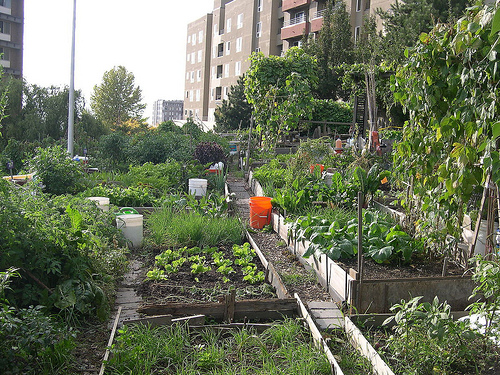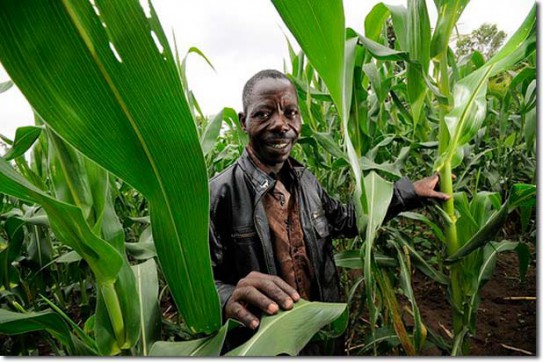As COP20 kicks off in Peru, Shweta Adhikari, a student at the Agriculture and Forestry University in Nepal, writes about seven climate-smart solutions for agriculture and how they are being put into action across the globe. This blog is part of our ongoing series with the Young Professionals for Agricultural Development network (YPARD).
Climate risk has been rising dramatically, bringing with it fears for associated species loss and habitat degradation. This comes as population growth is spiralling and urbanisation is increasing. Agriculture now requires greater transformation in order to ensure food security and reduce the impacts (or ‘mitigate’) this climate change.
As COP20 kicks off in Peru, Shweta Adhikari, a student at the Agriculture and Forestry University in Nepal, writes about seven climate-smart solutions for agriculture and how they are being put into action across the globe. This blog is part of our ongoing series with the Young Professionals for Agricultural Development network (YPARD).
Climate risk has been rising dramatically, bringing with it fears for associated species loss and habitat degradation. This comes as population growth is spiralling and urbanisation is increasing. Agriculture now requires greater transformation in order to ensure food security and reduce the impacts (or ‘mitigate’) this climate change.
Based on the projections for food consumption patterns, and the fact our global population will increase by one-third by 2050, agricultural production will need to increase by at least 70 percent. Impacts of climate change and global warming are likely to exacerbate the problems already apparent in agriculture, such as shifting production seasons, pest and disease patterns. The set of crops that will be fesiable to grow will also change, affecting production, prices, incomes and ultimately, livelihoods and lives. So climate-smart agriculture is a major necessity.
I am currently studying for a bachelors degree in Agriculture and Forestry in Nepal. With the increase in climate risk, developing countries like mine are becoming more vulnerable to food crises day by day, which is why I am determined to be part of the solution. For this blog, I have identified seven climate smart solutions from around the world that can be followed by both developing and developed countries to build their resilience to the changing climate.
1.Water harvesting in India
Drought-prone areas that rely on rain-fed agriculture are the most vulnerable to rising temperatures. Effective methods for capturing water will therefore be crucial in these regions. Traditional water harvesting techniques such as using jugs to collect rainwater, preserving dams and creating pits and ridges that also capture the vital runoff from rain, can all be applied for better production and to cope with climate change. This great example in Hyderabad, India has built Farm Ponds on the lower side of farm fields which collects the runoff from all the adjacent fields, making farming possible even without sophisticated irrigation technology.
2. Conservation agriculture in Zambia
The way we farm can also have an impact reducing carbon emissions, which will mitigate the effects of climate change. Some agriculture practices, known as conservation agriculture, advocate for a reduction in tillage, resulting in the retention of adequate levels of crop residues and soil surface cover. This also avoids soil compaction, reduces water run-off, increases aeration of the soils, and helps minimise the amounts of carbon lost in the soil. Reducing heavy machinery use also lessens the use of fossil fuels and lowers on-farm emission. A case study in Zambia showed that combining conservation agriculture with tree cultivation increases crop yields by 240–400 percent, enhances soil carbon sequestration and improves resilience to climate shocks.
VIDEO: Conservation agriculture in Africa.
3. Urban and peri-urban agriculture in U.S.A.
Urban agriculture is practice for growing fruits, herbs, and vegetables and raising animals in cities, a process that is accompanied by many other complementary activities such as processing and distributing food, collecting and reusing food waste and rainwater, and educating, organizing, and employing local residents. Urban agriculture helps to cope with climate change as it fulfils the growing need of growing population. Three cities already making headway in this approach are Seattle ,Washington and Portland where urban agriculture is meeting needs of people. By meeting local demand with locally grown products, pressure is reduced on the food chain and carbon that would be emitting in transporting food from further afield are eliminated.

4. Soilless agriculture in Philippines
Soilless agriculture (also known as hydroponics) can be performed in controlled environments and established virtually anywhere, as it isn’t dependent on land space and fertility. Soilless agriculture addresses many of the concerns we now have about traditional or industrial agriculture. This is an environmentally friendly farming system, it minimises the reduction in the quality of soil and the deterioration of the natural environment; it also saves energy and helps with carbon sequestration. Its products are fully organic, have a high nutritional value, and can be produced in the off-season. The productivity of this farming system is 3–7 times higher in some cases than traditional land-based agricultural production. Find out how the Philippines is making use of this technology with this short video.
5. Using symbiotic biological methods in Japan
Some biological methods also play a significant role to cope with climate change. The duck rice farming technique in Japan has effectively reduced the use of inputs in the field by applying symbiosis method.
VIDEO: Duck rice farming in Japan.
The farmer keeps ducks in his rice field, which eat insects and weeds which would damage his crop. The ducks’ excrement then acts as a fertilizer for the field as well as promoting the production of plankton, which feeds the fish. An aquatic plant called azolla also produces a natural supply of nitrogen which is crucial for the rice crop. This method is not only climate-smart, but is also affordable.
6. Biotecture in the United Kingdom
Biotecture is the direct integration of plant life and structures. This concept relates architecture to a more green life. Biotecture in the U.K. is a designer and supplier of hydroponic, modular living wall systems. Its main vision is to transform urban architecture for the well-being of people and planet through innovative use of vertical greening. Projects include retrofitting existing buildings with features like green roofs and living walls, and greening ground-level of buildings with pocket parks and rain gardens. Take a look at some of the latest projects here.
7. Permaculture in Kenya
Combining the best of natural landscaping and edible landscaping is the Permaculture. Permaculture aims for a site that sustains itself and the gardener. The ultimate purpose of Permaculture is to develop a site until it meets all the needs of its inhabitants, including food, shelter, fuel, and entertainment. Permaculture is being extensively practiced in Kenya. Farmer Maurice Kwadha has used discarded mango seeds to start a mango nursery, plants trees among his crops to improve soil quality and even hopes to feed his dairy cow from a “zero grazing” unit.

Climate change is a global problem which is directly affecting the agriculture system. But not every solution will work in every place. Biotecture and soilless agriculture require huge manpower, cost and much innovation. However solutions like permaculture and conservation agriculture are affordable and effective for developing countries as well. Many of these solutions are being practiced in many areas, but what we lack is a system. Farmers in developing countries are still uneducated and unaware of ways to get climate-smart. Finding solutions is not sufficient, what we require is ability to get these approaches into farmers hands, if we are to avoid climate change causing a food crisis.
Click here to read the original post on Farming First website.

